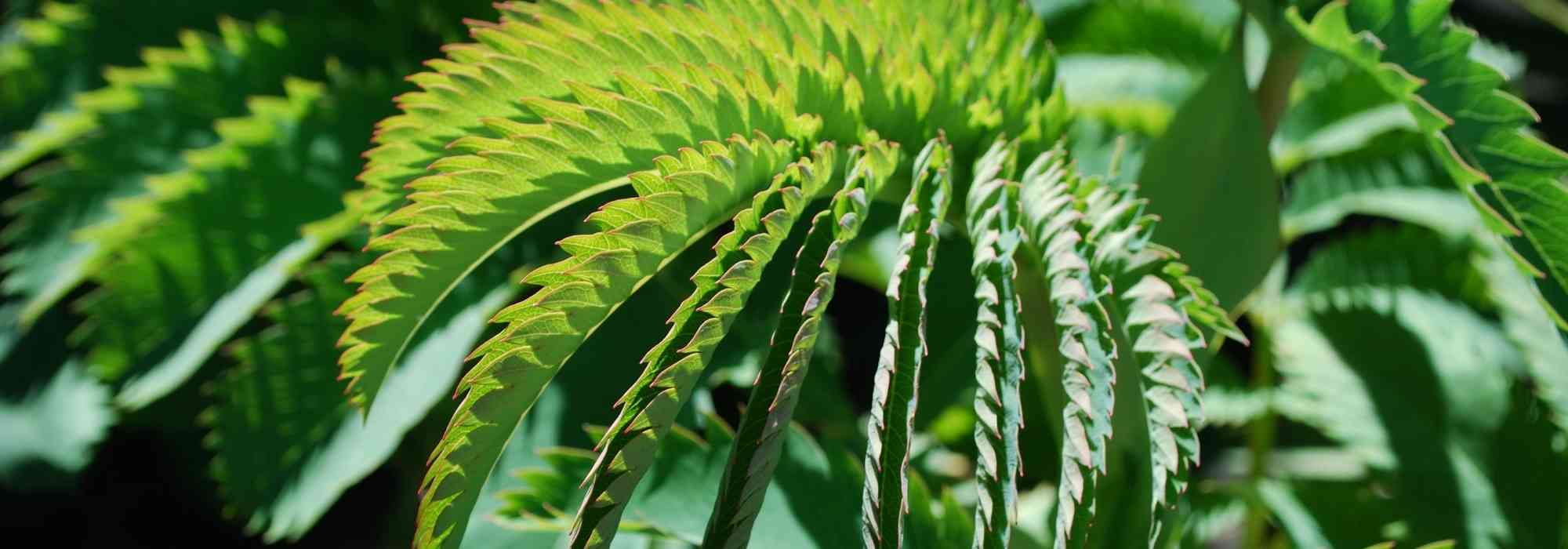
Large-leaved shrubs and trees
Our selection of large-leaved trees and shrubs
Contents
Large foliage irresistibly evokes the tropics and lushness. It is interesting to play with these ample leaves in the garden to create jungle-like atmospheres, providing a sense of travel and exuberance without leaving home. Many plants actually present a large foliar surface; they are often of tropical origin, where plants situated beneath the canopy strategically enlarge their laminae to capture as much light as possible and thus ensure their photosynthesis. Several trees and leafy bushes, evergreen or deciduous, also offer exceptional foliage, which we invite you to discover… or rediscover!
Paulownia tomentosa
Imperial if ever there was, Paulownia has the largest single leaves among leafy trees: they are truly gigantic, measuring between 30 and 50 cm long. That is not the only attraction of this impressive tree by size (it grows quickly, reaching 10 m in 10 years, then typically 15 m tall): its spring flowers on naked wood stand out beautifully, a purplish-blue rare among trees, trumpet-shaped and reminiscent of foxgloves. Note that foliage reaches those giant proportions when pruned short, which allows it to be kept as a smaller-sized tree but compromises flowering… Imperial Paulownia is a heat-loving tree that will thrive and enhance a large garden or park for many months (it retains its foliage for a long time).
Paulownia fortunei ‘Fast Blue’ is a smaller cultivar, more upright in habit, with the same leaf and flower qualities as the type species.
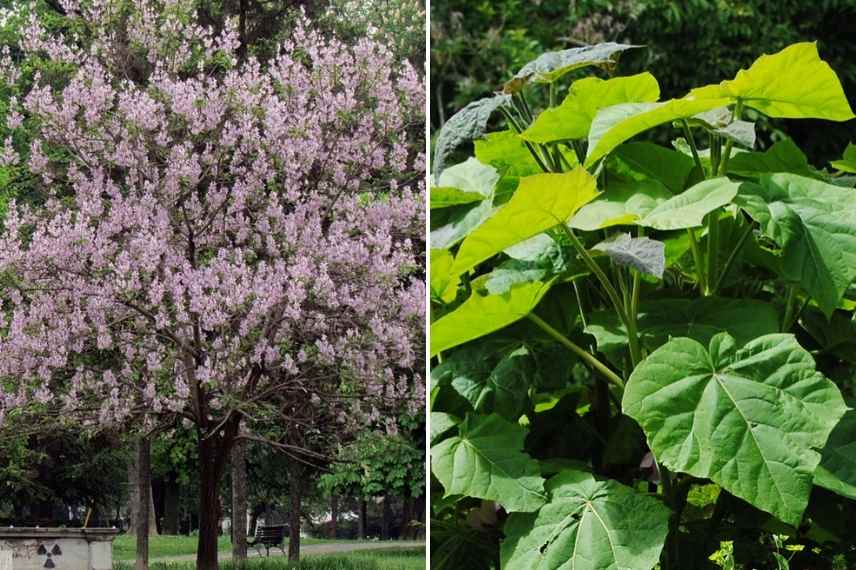
Paulownia tomentosa
Catalpa bignonioides
After Paulownia, Catalpa has the largest single leaves among deciduous trees: these measure between 15 and 20 cm. They are cordate (heart-shaped), whorled (inserted at the same level around an axis) in threes and a beautiful pale green colour. Catalpa, with its large foliage, gives your garden a slightly exotic air. It is an ideal shade tree for medium to large gardens; it reaches 8 m to 13 m in height with a spreading, even umbrella-like habit. Its flowering is another of its charms: it flowers in summer with beautiful clustered flowers, white speckled with purple, which develop into very long pods of 30 to 50 cm, enhancing the exotic aspect, and which persist on the bare tree. The dwarf variety ideal for small gardens (‘Nana’) has slightly smaller leaves.
Read also: Shade tree: choose Catalpa for a cool, elegant garden.
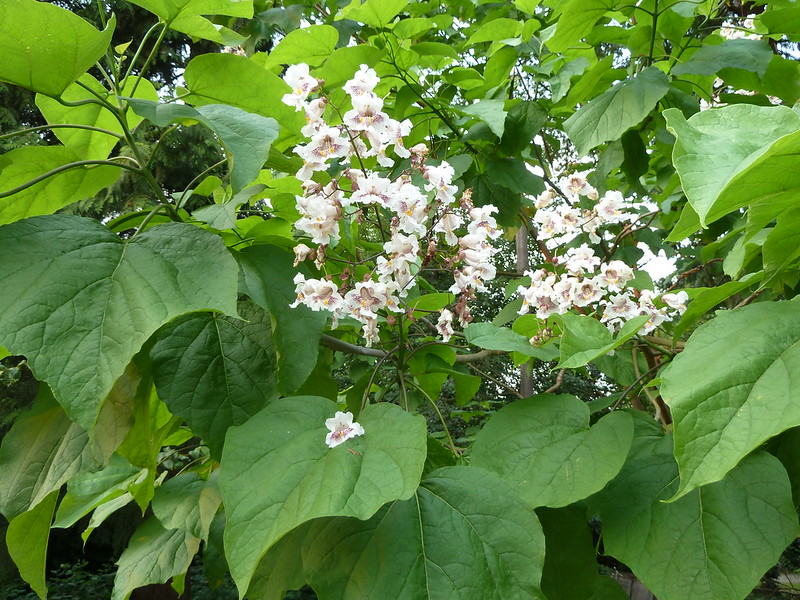
Catalpa bignonoides (© Wendy Culter)
Rhus typhina
Stag’s-horn sumach (Rhus typhina) has a very large odd-pinnate compound foliage that is remarkable: it changes through the seasons from green to yellow and adopts splendid orange-red to flame-red colours in autumn. The immense leaves are composed of about twenty leaflets and measure between 50 and 60 cm long. They give this large bush of spreading habit (wider than tall at ripeness) a very elegant appearance. Stag’s-horn sumach needs sun to develop its sublime autumn colours. It is suitable for all soils, very hardy, tolerant of drought and urban pollution. It has only one small drawback: it suckers easily! To avoid this, opt for new cultivars such as ‘Tiger Eyes’ which remain non-invasive. Varieties dissecta, also called laciniata, have a finely cut foliage that is truly superb (but a little smaller than the type).
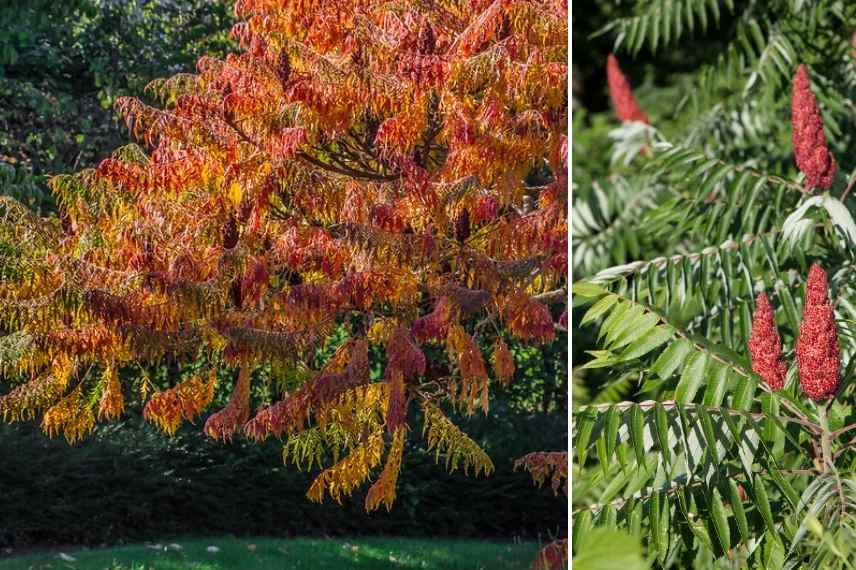
Rhus typhina: autumn foliage on the left (© Finn Termann Frederiksen), summer foliage and fruits on the right (fruits are produced only on female plants)
Fatsia japonica
Here is a bush that is becoming increasingly common in gardens and patios. It must be said that this false Aralia, which our grandmothers often grew indoors, has come back into fashion — and rightly so. Sporting broad, evergreen, superbly palmate leaves, it inevitably draws the eye. Leaves can reach up to 30 cm and are a glossy, highly decorative green, as is the habit of the Fatsia, which becomes upright. In autumn, it produces flowers grouped in umbels, resembling those of ivy (they are in the same family). Fatsia japonica is all the more interesting to plant in our gardens because, like no other, it can transform a shady corner into a little tropical haven when paired with a few other well-chosen plants that, like it, enjoy partial shade and fresh, well-drained soil. It withstands -15 °C… Enough said! This bush is a gem! You will easily find several varieties with cream-variegated leaves (‘Spider’s Web’ or ‘Variegata’).
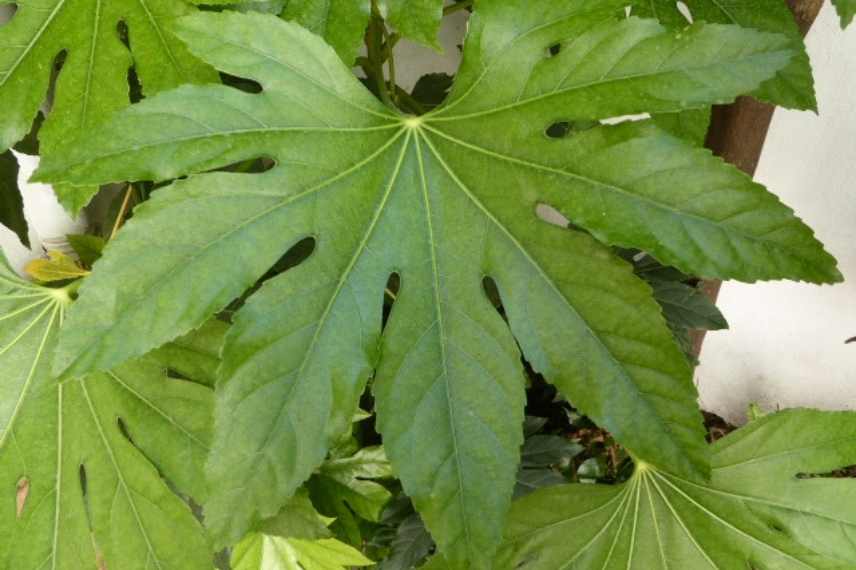
Fatsia japonica (© Gwenaëlle David)
→ Learn more about Fatsia japonica in our full factsheet: Japanese Fatsia: planting, growing and care
Tetrapanax
In the Fatsias series, how could we not mention Fatsia papyrifera, now better known as Tetrapanax or rice paper plant? This bush, sometimes classed among perennials, is spectacular for the size of its palmately divided leaves which recall — in an extra-large and more supple version — those of Fatsia japonica: they bear giant, very deeply cut, green and downy laminae, rounded in shape, 50 to 80 cm in diameter. Tetrapanax papyrifer develops especially luxuriantly, even in our latitudes (it is native to southern China), when planted in cool, light and fertile soil in partial shade. With rapid growth, it generally reaches 2 m in height with spreading up to 8 m! Needless to say, it is essential for anyone wanting to create an extraordinary tropical setting. You can pair it with a wide range evoking the tropics: Dicksonia antartica, Musas, Phormiums, Colocasias…
→ Discover our video: Tetrapanax papyrifera ‘Rex’ and find out everything about Tetrapanax in our complete fact sheet
Magnolia tripelata and Magnolia hypoleuca (obovata)
Evergreen magnolias are known for their very beautiful, large glossy leaves. Yet it is these deciduous Magnolias with admirable flowers that rank among the most beautiful and largest foliage: first, an East American Magnolia, Magnolia tripelata (also encountered under name Magnolia umbrella or Magnolia parasol) whose obovate leaves measure up to 60 cm long! It is exceptional with its spreading habit, white flowers appearing in May–June, and tender pale foliage with a strong exotic character that colours nicely in autumn. You can plant it even in a small garden, as it reaches 6 to 8 m tall at ripeness.
Another Magnolia worthy of inclusion in this selection of large foliage, even if its leaves measure “only” 40 cm long by 20 cm wide: Magnolia hypoleuca (also called Magnolia obovata) of Japanese origin. The slightly bluish, satiny leaves are sublime, and what to say of its cream flowering with magnificent prominent stamens. These two beautiful specimens are planted in slightly acidic soil, as solitary specimens to fully appreciate their beauty.
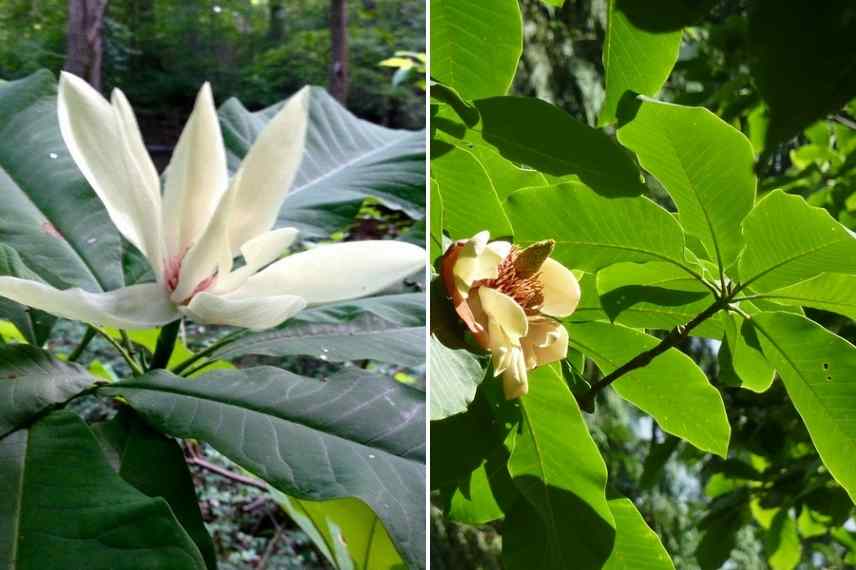
Magnolia tripelata and Magnolia hypoleuca (Leonora Enking)
Melianthus major
Native to South Africa, large Melianthus has a generous pale foliage, among the most graphic and spectacular, made up of dentate leaflets that form a leaf measuring about 40 to 50 cm long. These magnificent leaves are evergreen, with a superb bluish colour, jade at bud burst period. Stems are fairly rigid, they carry foliage as if suspended, giving plant both an upright and spreading habit. Melianthus major reaches 1.5–2 m at maturity. It can be grown in a large container on a sunny terrace in colder regions; it nevertheless tolerates some frost down to -5 °C, but will require a winter fleece except in coastal fringe.
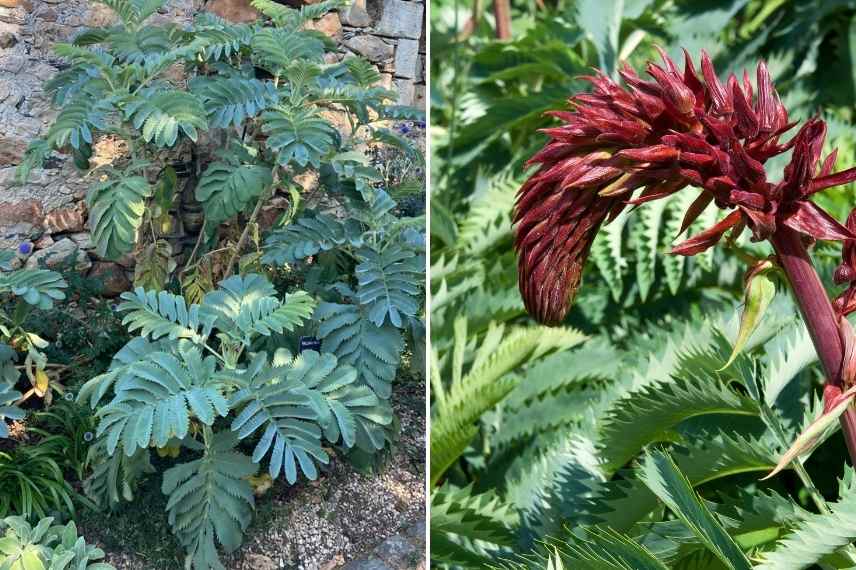
Melianthus major : habit (© Gwenaëlle David), and flower
Eriobotrya japonica
No, large foliage is not the preserve of trees for those lucky enough to have very large gardens! Loquat is one of my favourite small ornamental trees, for its ample, decidedly exotic foliage that it displays year-round: its long crinkled leaves measure between 20 and 25 cm. They are leathery, glossy above and downy and russet beneath. They have strongly marked veins, giving it a truly exotic appearance. The habit of this small tree is superb; it is spreading, forming almost an umbrella-like shape at ripeness. Despite its tropical look, it is hardy down to -12 °C and can be planted in many regions (only fruiting, the orange fruits appearing in winter – also called bibasses, will be compromised from -4 °C).
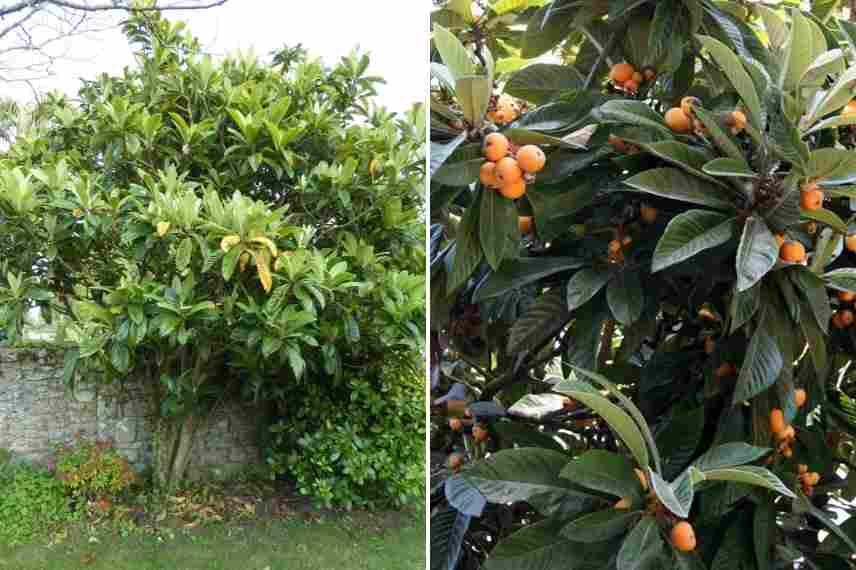
Eriobotrya japonica (© Gwenaelle David)
Liriodendron tulipifera
The Virginia tulip tree is a very beautiful deciduous tree, whose quadrilobate leaves are quite unique: terminal lobes are spread apart, giving Liriodendron a very unusual and characteristic appearance. A leaf of a lovely light green is about 15 cm long, turning a magnificent orange-yellow in autumn. Liriodendron is therefore easily recognised by this foliar peculiarity, but also by its sublime summer flowering, likewise singular, shaped like large tulips with upright stamens. Flowering, unfortunately, occurs only on trees about fifteen years old. This large tree of about twenty metres at ripeness prefers rich, fresh, acidic or neutral soils, and will establish itself in a large garden or park.
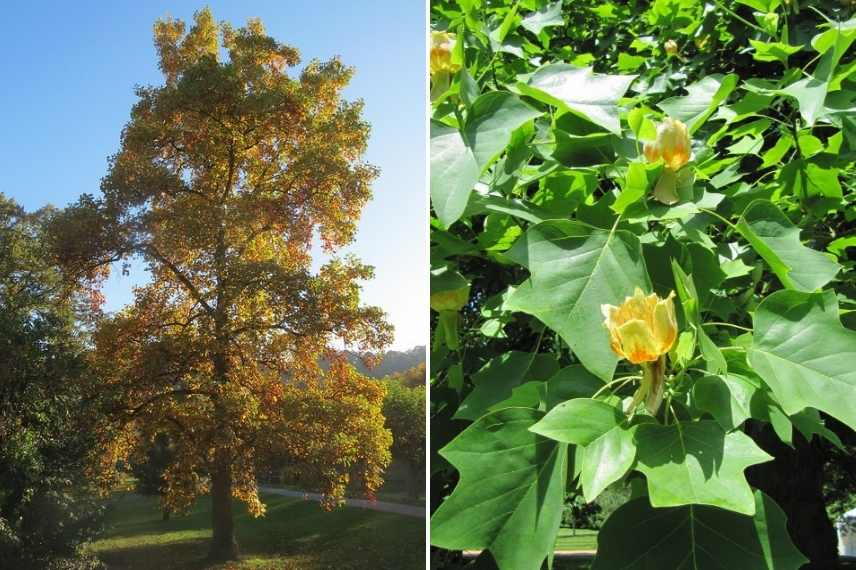
Liriodendron tulipifera: habit (© Andreas Rockstein), leaves and flowers (© Leonora Enking)
Pinus wallichiana
Why mention a conifer among these broadleaves? Because Himalayan weeping pine isn’t that widespread and has flexible needles among the longest in this large family. Its sweeping, graceful brooms are truly worth seeing, giving it a very distinctive style. They are very thin bluish-green needles, grouped into a myriad of brooms, measuring between 20 and 30 cm long. Pinus wallichiana can be grown as a single trunk, or as coppice shoots (multiple trunks). Plant in full sun as a specimen on a short grass meadow in a large garden (it reaches 15 m). It is particularly hardy and copes with any type of soil.
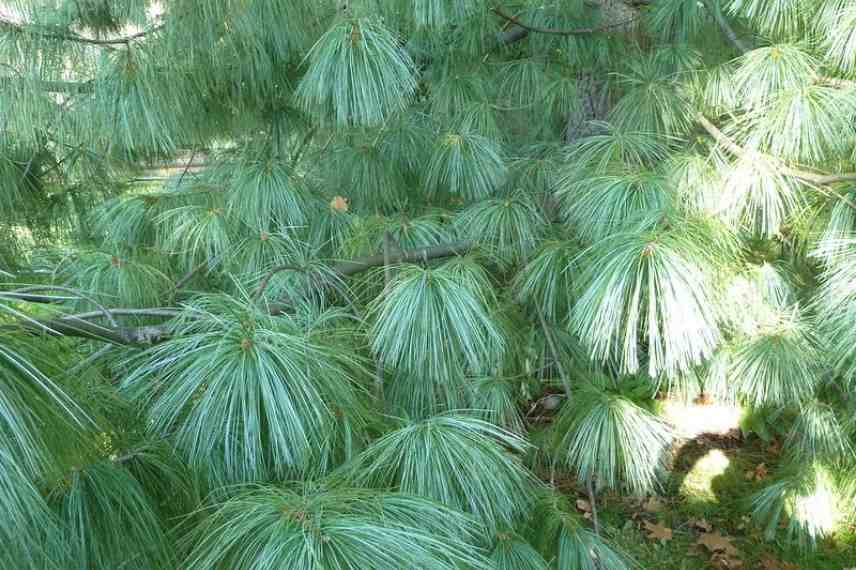
Foliage of Pinus wallichiana (© Wendy Cutler)
Quercus frainetto
Better known as Hungarian oak, Quercus frainetto stands out for its particularly large and distinctive foliage: deciduous leaves measure about 20 cm and are notably lobed, changing from light green in spring to glossy dark green in summer and golden yellow in autumn. Hungarian oak thrives in full sun or partial shade and tolerates calcareous soil. Notable for its fairly rapid growth and the light shade it provides in summer, this majestic tree reaches 20 m in height with a spread of about 12 m… therefore best reserved for park-like gardens!
Quercus dentata ‘Grandifolia’, a marcescent cultivar from Japan (‘Oh-gashiwa’), somewhat harder to find, has incredible leaves up to 40 cm long!
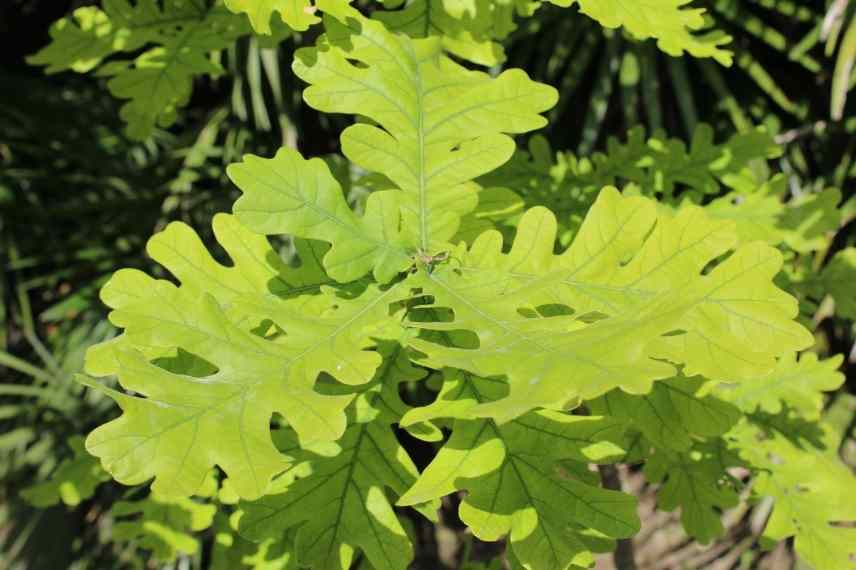
Quercus frainetto : spring foliage
But also a wide range from tropical regions …
This selection is fairly limited in the end; it could have included the remarkable foliage of other trees, notably the silky Albizia, Sassafras albidum with its very beautiful lobed leaves, fig trees and mulberry trees (including Broussonetia papyrifera), certain Mahonia, and many trees and bushes of tropical origin such as Brugmansia with its fabulous tropical flowers… and many palms! They almost deserve a separate article, so much their large-scale foliage ranks among the most beautiful in the plant world. Not to mention banana plants and some large succulent plants such as Agaves. You’re spoilt for choice when creating ultra-exotic displays in the garden…
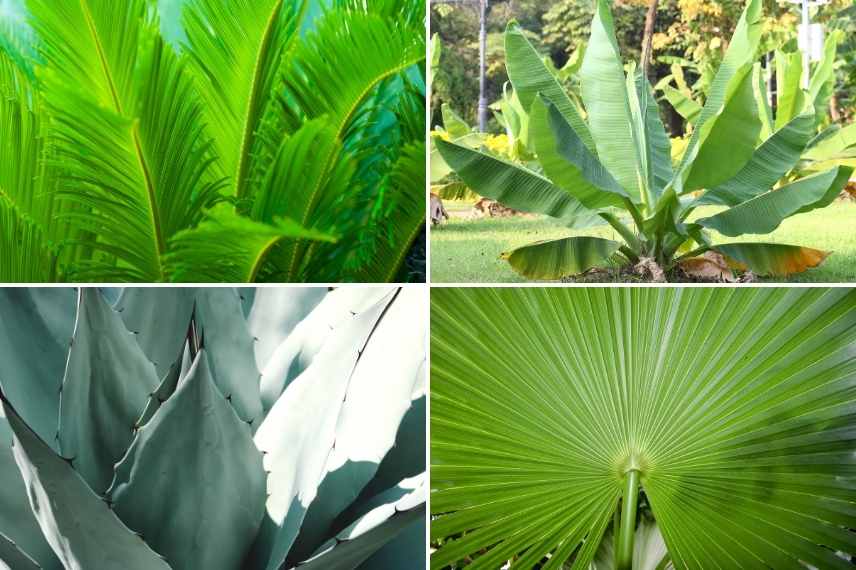
Impressive foliage of Cycas revoluta, Agave, banana plant and Washingtonia robusta
- Subscribe!
- Contents
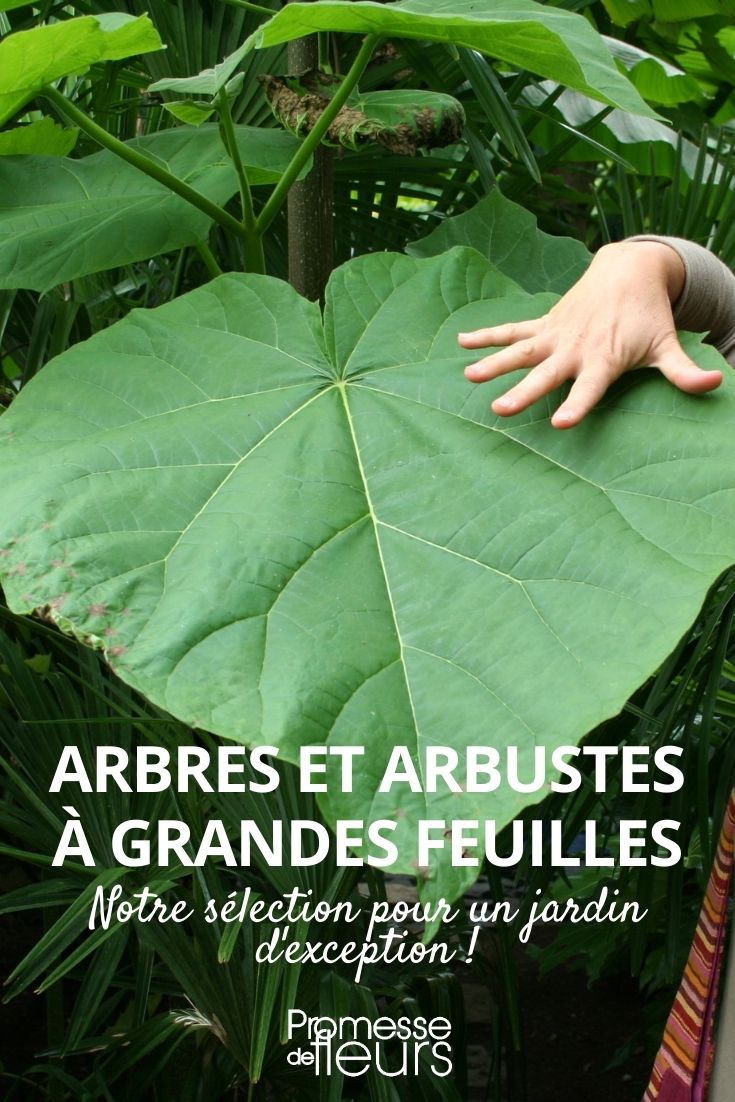































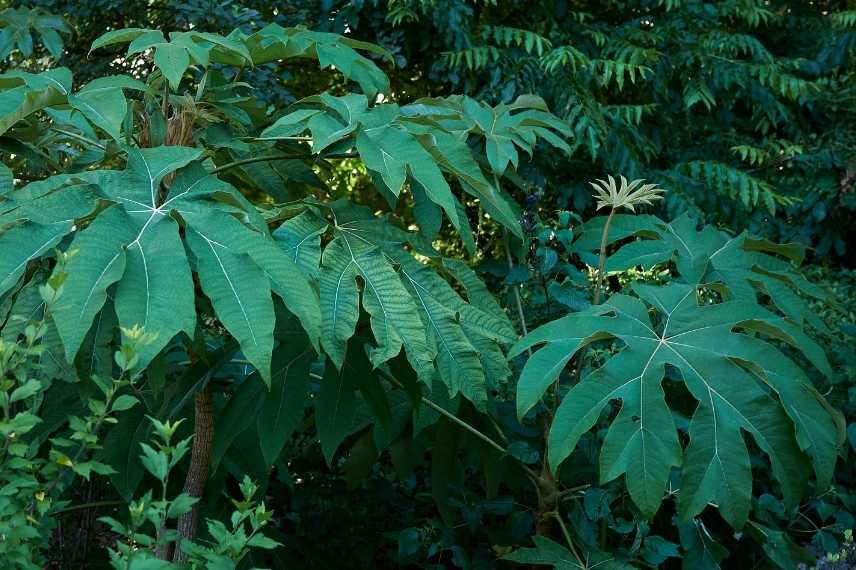
Comments